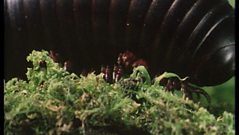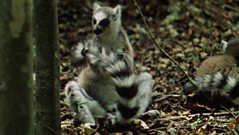
Why even the vegetarian dinosaurs were gigantic
Dinosaurs needed huge stomachs to digest their food, and huge stomachs need huge bodies. Another reason: the recurring problem for all reptiles, temperature control.
David Attenborough looks at the skeleton of a brontosaurus, one of the biggest dinosaurs ever. It was over 60 feet long and weighed around 30 tons. But why did these vegetarian dinosaurs grow so big?
There are at least two possible answers. The plants they ate - cycads and ferns - would have been tough, fibrous and difficult to digest. And since the brontosaurus had relatively feeble teeth, it would have needed a huge stomach in which the food could have fermented for very long periods of time. But a huge stomach requires a huge body to carry it.
Another reason why they grew so large may have been to do with the recurring problem for all reptiles: temperature control. The bigger the body, the less susceptible it is to variations in temperature because a big body retains its heat for longer.
Temperature control may have also been the reason for the bizarre body shape of another type of dinosaur - the stegosaurus. The stegosaurus had plates on its back that people used to think were a kind of armour.
But scientists have now discovered that the plates would have been covered by skin that was thick with blood. The plates therefore acted as solar panels to heat the animal's blood.
If the animal overheated then all it needed to do was turn away from the sun for them to act as very efficient cooling radiators. This ability to influence temperature would have been invaluable.
In Texas, the muds of an ancient estuary have now turned to rock and preserve the yard-wide footprints of a giant herbivorous dinosaur - a vivid record of these creatures. Also visible are the footprints of a flesh-eating dinosaur that was 10 to 12 feet tall.
Duration:
This clip is from
Featured in...
![]()
麻豆社 Nature
Be captivated, informed and inspired by the world's wildlife.
More clips from Life on Earth
-
![]()
Lucky pups—The Rise of the Mammals
Duration: 03:29
-
![]()
Millennia of millipedes—The First Forests
Duration: 01:50
-
![]()
Creatures of the night—Life in the Trees
Duration: 01:16
-
![]()
Scent sense—Life in the Trees
Duration: 02:55






